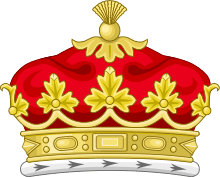Cromartie Sutherland-Leveson-Gower, 4th Duke of Sutherland
| The Duke of Sutherland | |
|---|---|
 | |
| Born |
20 July 1851 London |
| Died | 27 June 1913 (aged 61) |
| Title | Duke of Sutherland |
| Tenure | 22 September 1892 – 27 June 1913 |
| Other titles | Earl of Sutherland |
| Predecessor | George Sutherland-Leveson-Gower, 3rd Duke of Sutherland |
| Successor | George Sutherland-Leveson-Gower, 5th Duke of Sutherland |
| Spouse(s) | Lady Millicent St Clair-Erskine |
| Parents | George Sutherland-Leveson-Gower, 3rd Duke of Sutherland |
Cromartie Sutherland-Leveson-Gower, 4th Duke of Sutherland KG (20 July 1851– 27 June 1913[1]), styled Lord Cromartie Sutherland-Leveson-Gower until 1858, Earl Gower between 1858 and 1861 and Marquess of Stafford between 1861 and 1892, was a British peer and politician from the Leveson-Gower family.
Background
Sutherland was the eldest son of George Sutherland-Leveson-Gower, 3rd Duke of Sutherland. He was born in London and educated at Eton College.[2] Despite being very wealthy, Sutherland became concerned that his landed estates were no longer viable. Towards the end of his life he disposed of properties in the UK (such as Trentham Hall and Stafford House) and began moving his wealth to Canada.[3] His political allegiances shifted from the Liberal Party to the Conservative Party.
Military career
As Marquess of Stafford, Sutherland entered the 2nd Life Guards as Cornet, retiring from regular army service as Lieutenant in 1875.[2] He was commissioned Captain in the Staffordshire Yeomanry in 1876 and commanded that regiment as Lieutenant-Colonel from 1891 to 1898, after which he became its honorary colonel.[4] He was also Lieutenant-Colonel of the Sutherland Rifles, a volunteer regiment of his Scots ducal county, from 1882 to 1891.[2] From 1911 to his death he was honorary colonel of the 5th Territorial Force battalion of the Seaforth Highlanders.[5]
He was President of the Staffordshire Territorial Forces Association from the formation of the Territorial Force in 1908.[5]
Political career
Sutherland served as MP for Sutherland. On succeeding to his father's peerage in 1892, he became a member of the House of Lords, sitting on the Conservative benches. He was also served as Mayor of Longton, near Stoke-on-Trent, Staffordshire, in 1895-96, and was Alderman of the borough from 1898.[5]
Honours
The Duke was made KG in 1902.[2]
Sporting Interests
The Duke was for some time Master of Foxhounds of the North Staffordshire Hunt.[6]
Family
He married Lady Millicent St Clair-Erskine, daughter of Robert St Clair-Erskine, 4th Earl of Rosslyn, on 20 October 1884. They had four children:
- Lady Victoria Elizabeth Sutherland-Leveson-Gower (1885–1888), died young.
- George Granville Sutherland-Leveson-Gower, 5th Duke of Sutherland (1888–1963)
- Lord Alastair St. Clair Sutherland-Leveson-Gower (1890–1921), married Elizabeth Demarest (ex-wife of John G. A. Leishman Jr) and had Elizabeth Sutherland-Leveson-Gower, 24th Countess of Sutherland.
- Lady Rosemary Millicent Sutherland-Leveson-Gower (1893–1930), married William Ward, 3rd Earl of Dudley and had issue. Died in a plane crash with Frederick Hamilton-Temple-Blackwood, 3rd Marquess of Dufferin and Ava.
In 1900 the Duke of Sutherland owned about 1,358,000 acres (550,000 hectares) and the steam yacht Catania, which was chartered by some of the super-rich of that era.
The Duke died at Dunrobin Castle, Sutherlandshire, on 27 June 1913, aged sixty-one, and was buried at Dunrobin.[6]
References
- ↑ Who's Who 1914, p. xxiv, has 26 June as the date of death
- 1 2 3 4 The Complete Peerage, Volume XII. St Catherine's Press. 1953. p. 567.
- ↑ Duke of Sutherland dead, New York Times
- ↑ Kelly's Handbook of the Titled, Landed and Official Classes, 1900. Kelly's. p. 1301.
- 1 2 3 Kelly's Handbook of the Titled, Landed and Official Classes, 1913. Kelly's. p. 1648.
- 1 2 The Complete Peerage, Volume XII. p. 568.
External links
- Works by or about Cromartie Sutherland-Leveson-Gower, 4th Duke of Sutherland at Internet Archive
- Hansard 1803–2005: contributions in Parliament by the Duke of Sutherland
- "SUTHERLAND, 4th Duke of (cr. 1833), Cromartie Sutherland-Leveson-Gower". Who's who biographies, 1901. p. 1084.
| Parliament of the United Kingdom | ||
|---|---|---|
| Preceded by Lord Ronald Gower |
Member of Parliament for Sutherland 1874–1886 |
Succeeded by Angus Sutherland |
| Honorary titles | ||
| Preceded by The 3rd Duke of Sutherland |
Lord Lieutenant of Sutherland 1892–1913 |
Succeeded by The 5th Duke of Sutherland |
| Peerage of the United Kingdom | ||
| Preceded by George Sutherland-Leveson-Gower |
Duke of Sutherland 1892–1913 |
Succeeded by George Sutherland-Leveson-Gower |